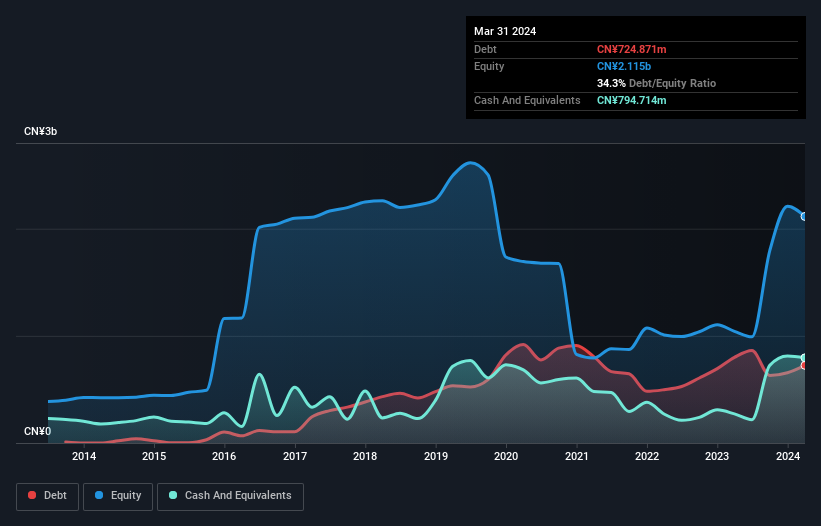- China
- /
- Communications
- /
- SZSE:300353
Health Check: How Prudently Does Kyland Technology (SZSE:300353) Use Debt?
David Iben put it well when he said, 'Volatility is not a risk we care about. What we care about is avoiding the permanent loss of capital.' When we think about how risky a company is, we always like to look at its use of debt, since debt overload can lead to ruin. As with many other companies Kyland Technology Co., Ltd. (SZSE:300353) makes use of debt. But the real question is whether this debt is making the company risky.
What Risk Does Debt Bring?
Debt assists a business until the business has trouble paying it off, either with new capital or with free cash flow. If things get really bad, the lenders can take control of the business. While that is not too common, we often do see indebted companies permanently diluting shareholders because lenders force them to raise capital at a distressed price. Of course, plenty of companies use debt to fund growth, without any negative consequences. When we examine debt levels, we first consider both cash and debt levels, together.
View our latest analysis for Kyland Technology
How Much Debt Does Kyland Technology Carry?
As you can see below, Kyland Technology had CN¥724.9m of debt at March 2024, down from CN¥799.1m a year prior. However, its balance sheet shows it holds CN¥794.7m in cash, so it actually has CN¥69.8m net cash.

How Strong Is Kyland Technology's Balance Sheet?
We can see from the most recent balance sheet that Kyland Technology had liabilities of CN¥1.27b falling due within a year, and liabilities of CN¥333.6m due beyond that. Offsetting this, it had CN¥794.7m in cash and CN¥906.5m in receivables that were due within 12 months. So it actually has CN¥94.5m more liquid assets than total liabilities.
This short term liquidity is a sign that Kyland Technology could probably pay off its debt with ease, as its balance sheet is far from stretched. Succinctly put, Kyland Technology boasts net cash, so it's fair to say it does not have a heavy debt load! When analysing debt levels, the balance sheet is the obvious place to start. But ultimately the future profitability of the business will decide if Kyland Technology can strengthen its balance sheet over time. So if you're focused on the future you can check out this free report showing analyst profit forecasts.
In the last year Kyland Technology had a loss before interest and tax, and actually shrunk its revenue by 4.5%, to CN¥1.1b. That's not what we would hope to see.
So How Risky Is Kyland Technology?
Although Kyland Technology had an earnings before interest and tax (EBIT) loss over the last twelve months, it made a statutory profit of CN¥232m. So when you consider it has net cash, along with the statutory profit, the stock probably isn't as risky as it might seem, at least in the short term. We'll feel more comfortable with the stock once EBIT is positive, given the lacklustre revenue growth. There's no doubt that we learn most about debt from the balance sheet. However, not all investment risk resides within the balance sheet - far from it. To that end, you should learn about the 3 warning signs we've spotted with Kyland Technology (including 2 which shouldn't be ignored) .
At the end of the day, it's often better to focus on companies that are free from net debt. You can access our special list of such companies (all with a track record of profit growth). It's free.
Valuation is complex, but we're here to simplify it.
Discover if Kyland Technology might be undervalued or overvalued with our detailed analysis, featuring fair value estimates, potential risks, dividends, insider trades, and its financial condition.
Access Free AnalysisHave feedback on this article? Concerned about the content? Get in touch with us directly. Alternatively, email editorial-team (at) simplywallst.com.
This article by Simply Wall St is general in nature. We provide commentary based on historical data and analyst forecasts only using an unbiased methodology and our articles are not intended to be financial advice. It does not constitute a recommendation to buy or sell any stock, and does not take account of your objectives, or your financial situation. We aim to bring you long-term focused analysis driven by fundamental data. Note that our analysis may not factor in the latest price-sensitive company announcements or qualitative material. Simply Wall St has no position in any stocks mentioned.
About SZSE:300353
Kyland Technology
Provides industrial Ethernet technology in China and internationally.
High growth potential with mediocre balance sheet.
Market Insights
Community Narratives




